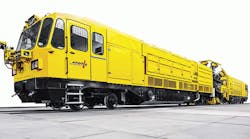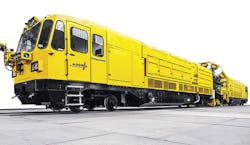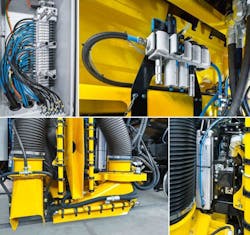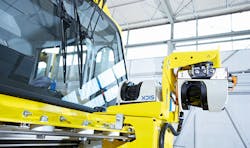This file type includes high-resolution graphics and schematics when applicable.
Extensive subway networks are an essential component of large cities worldwide. Subway trains move millions of people every day quickly and with no direct emissions, thanks to their electric drives.
However, just as the stations must be cleaned regularly, so do the tunnels. In particular, fine dust deposits accumulate over time, which can lead to increased maintenance and wear on the trains, as well as have a negative impact on the health of passengers and transit staff.
A new type of tunnel maintenance train was built to improve the cleanliness of subways and make the job faster, easier, more effective, and at lower cost. Although the vehicles are driven electrically and use extensive hydraulics to deploy much of the mechanisms, servopneumatics from Festo Corp. plays a key role in the cleaning process.
Cleaning Vehicle is No Lightweight
The tunnel-cleaning train weighs 85 metric tons (94 t) and is 40 m (130 ft.) long. The cleaning unit itself is located between locomotives at both ends of the train. The tunnel-cleaning train is faster, more economical, and more effective than manual cleaning. It moves at up to 5 km/hr (3 mph) while cleaning and can reach 70-km/hr (45 mph) speeds while in transit. Each locomotive has a driver's cabin, so the train can clean from either direction without having to turn round.
The front and rear halves of the train are nearly identical, with each half having its own hydraulic and pneumatic system. The hydraulic systems, mounted directly behind the driver's cabs, provide consistent results because they automatically adjust parameters according to the train’s speed. Each half of the train also contains three air turbines, which produce 6 m3/sec of air flow to clean tunnel surfaces.
The discharge side of the turbines generates the compressed air to blast dust, dirt, and debris from the walls. The suction side pulls a partial vacuum to immediately draw the dirt-laden air into the train’s filtration system. Dense debris falls into collecting bins and airborne particles are filtered out before the air is discharged.
Keeping the Profile in View
With a clearance of between 100 mm and 300 mm, the suction nozzles and suction feet follow the tunnel wall and track bed as the vehicle advances through a tunnel. Two laser scanners at both ends of the train constantly sense the tunnel profile. The system controller analyzes the contours of the next 20-m section in fractions of a second and sends appropriate control pulses to the individual suction nozzles. Therefore, the changing positions of the cleaning units remain close enough to the tunnel walls to effectively remove dirt at all times. If the laser scanners detect obstacles, such as signs or electronic switch boxes, the control simply retracts the respective suction arms to prevent impact.
This gigantic cleaning system is operated by just two people—a locomotive driver and the machine operator. Video cameras and eight monitors per driver’s cab allow for constant supervision of the most important areas of the machine. Depending on the type of application, up to seven people can fit into each of the two driver’s cabs.
Servopneumatics for Increased Safety
Festo’s closed-loop servopneumatic system offers fast response for precise positioning, and the compliance of pneumatics offers safe operation by automatically accounting for inevitable surface irregularities as the train advances through the tunnel. The quick and safe movement of the suction nozzles and suction feet is the work of the latest servopneumatics from Festo, which supplied two MSB6 service unit combinations and 16 standard DNCI-63 cylinders with integrated displacement encoder, including 16 position CPX-CMAX controllers to ensure that the suction nozzles and feet move quickly into their programmed positions.
Even large loads can be accelerated and decelerated with high dynamic response. Sixteen proportional valves control the supply and exhaust air to and from the cylinders. The CPX system is the automation platform, serving both as an electric terminal equipped with Festo's CMAX controllers and as a valve terminal equipped with VTSA valves for additional switching functions in the system.
A laser scanner at each end of the train is moved by DGCI-40 rodless cylinder with integrated displacement encoder and commanded through a VPWP-8 proportional valve. The fast, precise interaction between cylinder and valve provides optimum positioning of the scanners, allowing them to supply accurate data about the expected tunnel profile to the system controller.
Small Space, Safe Operation
The train's designers specified Festo's easy-to-install and space-saving double VABP sub-base. It replaces multiple individual components that had been used for various emergency-stop functions of servopneumatic axes. The OEM's project manager explains, “Installed between the drive and power valve, the sub-base enables different switch-off functions to be realized using only one unit for
stopping, exhausting, reversing left or right with reduced speed, and pressure compensation.”
Compared to solutions that must be assembled using individual components, the double sub-base VABP and ISO VSVA switching valves make it easier for the customer to evaluate the system according to EN Machinery Directive ISO 13849-1 and to determine the Performance Level that can be achieved.
Cooperation from Day One
The latest model of the tunnel-cleaning train is being used in Beijing’s underground rail system. Its network is around 460 km long, making it the largest in the world. The project manager says the design process, from initial discussions with the underground rail operators in China to completion of the tunnel-cleaning train, took just seven months. “For us, it was hugely important that we had a partner like Festo.”
Only a few months after both companies met at the 2012 Hannover Fair, a prototype for the servopneumatic system was developed. This was then used to produce the final product. Service technicians from Festo delivered and commissioned the entire servopneumatic system for moving and controlling the suction nozzles. In addition to fast delivery of the technological hardware, the worldwide service provided by Festo was a major selling point for the OEM. This will help ensure a clean environment for people and machines in the tunnels of underground rail networks all over the world.
For more information, call Festo, Hauppauge, N.Y., at (800) 993-3786, or visit www.festo.com/us.





